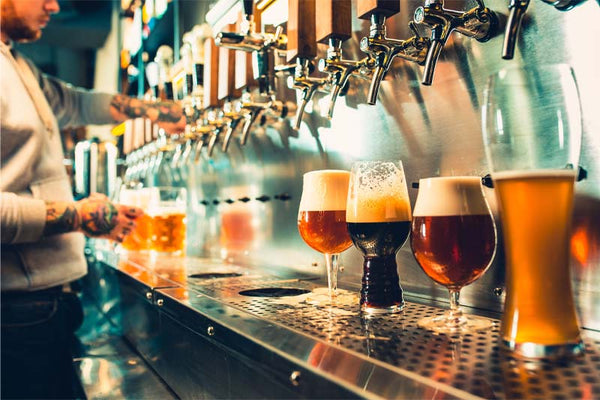Choosing the Best Direct Draw Beer System

For busy bartenders and smart bar managers, direct draw beer systems and draft beer serving equipment are great ways to accentuate your customer’s experience while helping your bartenders do more on a shift and appear more capable. Choosing from the best draft beer system for sale means knowing a little more about how these items work, and understanding the context around purchasing this type of bartending equipment.
Main Uses of Direct Draw Beer Systems
The main point of buying one or more of these direct draw beer systems or draft beer systems is to conveniently hide the container or “vessel” from which you’re drawing your beer. Many of these systems work with a keg container of one size or another, or (for some of the larger models) with multiple kegs. If you think about what happens when you use a keg without one of these systems, you see the value of having a direct draw beer system to house the keg in.
At informal parties, people simply pick up a tap hose to fill a cup, and then set it back down on top of the tap. That's generally pretty unhygienic, and shouldn’t be up to the standard of even your average dive bar, but it’s done all the time. So with state-of-the-art direct draw beer systems, the keg stays hidden, the beer stays colder, and busy bartenders are able to fill glasses in a more practical and aesthetic way. Here are some tips for selecting the best direct draw beer systems for your bar restaurant business.
Calculate Size - And Number of Kegs and Taps
One of the first big considerations is fitting your direct draw beer system into the floor plan. These items do take up valuable space behind the bar, so you'll want to do the math, to fill only the space that you need. In addition, many of these systems house multiple kegs, and operate multiple taps. The number of kegs isn't always the same as the number of taps – you may want to purchase, for example, a four-keg, two-tap system, to have a choice of two different drafts, with multiple containers for each one. That’s the kind of math you’ll have to do when thinking about how to set up a draft beer direct draw system behind your bar.
As a further note on choosing a particular size and number of keg containers, it's important to know that the other major option for bartending is a remote draw system, where the kegs are actually housed in some remote location, like a walk-in refrigerator or auxiliary closet. The direct draw beer systems, on the other hand, have the container and the tap built right in, which is convenient, unless you're trying to change out kegs one after the other behind a busy bar. In that case, you're going to want to rethink your strategy and select either a remote draw operation, or a direct draw beer system that's big enough to accommodate your bartender's needs for a certain time frame.
Evaluate Cooling Options
As mentioned, one of the key values of a direct draw beer systems is related to keeping the beer properly chilled. With that in mind, some of the best draft beer systems have specific chilling features that allow bartenders to deliver colder beer to customers. Some have a cold air column all the way up to the top of the tap, or “cold air throughout the box” that's going to keep the beer closer to its refrigerated temperature as it's being drawn and distributed. Keeping the beer colder also reduces foam, which is how bartenders are able to offer you a frosty cold glass of beer with very little head. As experienced bartenders will tell you, this clean, foamless beer is a hallmark of a good bar operation.
Evaluate Insulation and Energy Design
Because these are chilling pieces of equipment, it's important to look at their energy ratings. Some have better and more environmentally friendly insulation, with ratings for ozone depletion potential and global warming potential. Some have better door sealing technologies, to keep cool air where it needs to be. These features can factor into your buying decision.
Bottle, Can and Mug Chillers
Many buyers like to look for direct draw beer systems that also offer a combined cooling area for bottles and cans, or even the mugs and glasses that you serve the beer in. Frosting mugs is a popular bartending strategy. As for the bottles and cans, if a bar is doing a brisk business in take-out, having the to-go items located with the keg can be a bonus in terms of efficient bartending.
Some types of club top dispensers are great for this kind of double functionality. Some models also have bottle or glass rails in place. It's also helpful to look for corrosion handling features and drain pans, so that overflow doesn't put too much wear on your equipment over time. With all of these things floating around in your head, you should be able to narrow down your search for the best direct draw beer systems for your bar. We know the challenges of sourcing the very best restaurant and bar equipment.
At Chefs’ Toys, we are restaurant people ourselves. We are “for chefs, by chefs,” and we want to help your kitchen to be all it can be. Get everything you need to win at the restaurant business from our extensive catalog, with helpful guides and other resources to help you up your game in a challenging market.

















